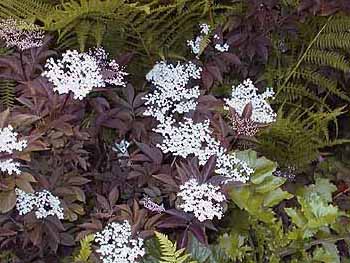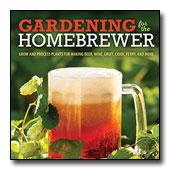Sambucus nigra 'Purpurea'
ELDERBERRY, BLACK ELDER, EUROPEAN ELDER
Family: Caprifoliaceae
Quick Jumps
Growing Guide
Rainy Side Notes
GROWING GUIDE

Origin:
Europe, southwest Asia, and north Africa.
Plant Group:
Shrubs.
Hardiness:
Sunset zones: 2-7, 14-17.
USDA zones: 6-8.
Heat zones: 8-6.
Mature size:
Height 20 feet (6 m).
Width: 20 feet (6 m).
Flowering period:
Late spring to early summer.
Flowering attributes:
White flowers, pink tinged in panicles up to 8 inches across, on purple stalks.
Leaf attributes:
Dark green leaves that turn a very dark purple.
Growth habit:
Upright shrub.
Light:
Full sun to partial shade.
Soil:
Fertile, moist, well-drained soil. Side dress with manure in spring.
Propagation Methods:
Hardwood cuttings in winter.
Greenwood cuttings in early summer.
Pruning Methods:
Prune hard to within 2 to 3 buds at the base while shrub is dormant.
Pests and Diseases:
Powdery mildew may be a problem.
Rainy Side Notes
Sambucus nigra 'Purpurea' is now collected under the umbrella of the name S. 'Guincho Purple' along with S. 'Foliis Purpurea', and S. 'Porphyrifolia'.
Although there is caution given with S. nigra planted in the garden I haven't seen it be weedy. In fact it is certainly proven much more behaved than our native red elderberry that likes to seed under decks and in the middle of walkways.
The flowers and berries are edible making a good reason to grow it. But the handsome purple foliage and beautiful flowers is the reason I give space for it in my garden. Planted on the east side of my home in partial shade, it springs up each spring after a hard pruning and graces the garden with its dark purple leaves. Planted close by, Clematis cirrhosa tries to weave its way around the shrub. The annual pruning of this elderberry helps me keep the clematis over on a large stump it is supposed to be covering.
Black elder grows well in a mixed border, bringing a deep foliage color throughout the growing season with leaves turning red in autumn.
Photographed in author's garden.

Gardening for the Homebrewer: Grow and Process Plants for Making Beer, Wine, Gruit, Cider, Perry, and More
By co-authors Debbie Teashon (Rainy Side Gardeners) and Wendy Tweton

